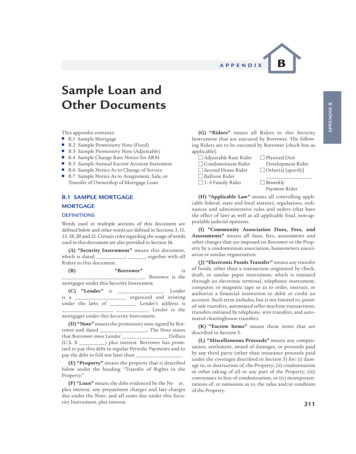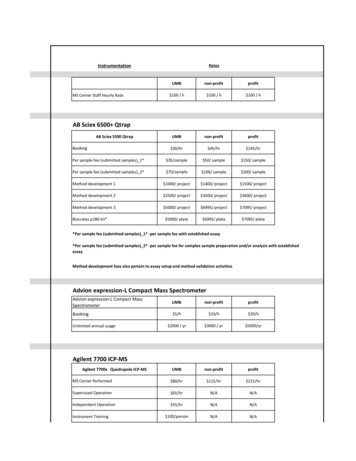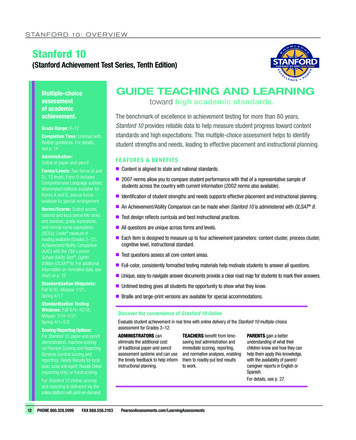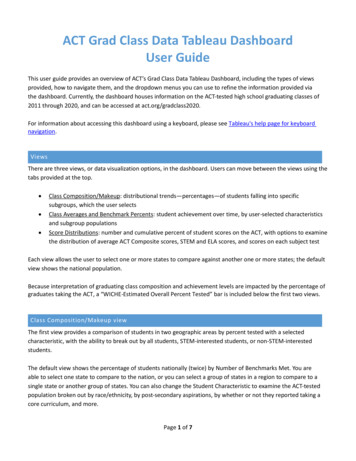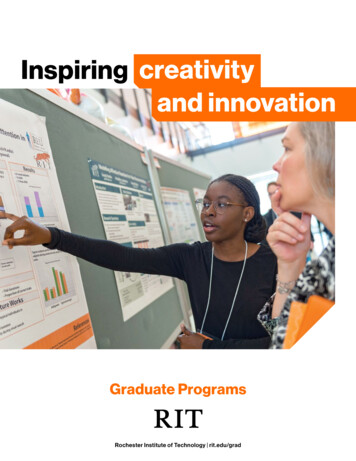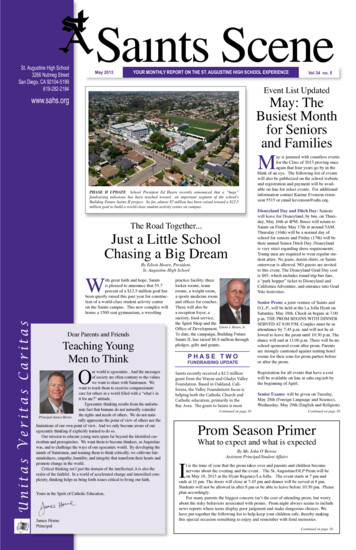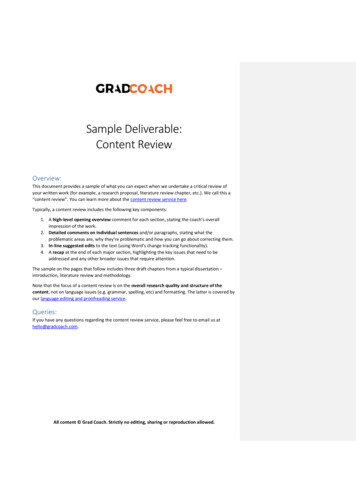
Transcription
Sample Deliverable:Content ReviewOverview:This document provides a sample of what you can expect when we undertake a critical review ofyour written work (for example, a research proposal, literature review chapter, etc.). We call this a“content review”. You can learn more about the content review service here.Typically, a content review includes the following key components:1. A high-level opening overview comment for each section, stating the coach’s overallimpression of the work.2. Detailed comments on individual sentences and/or paragraphs, stating what theproblematic areas are, why they’re problematic and how you can go about correcting them.3. In-line suggested edits to the text (using Word’s change tracking functionality).4. A recap at the end of each major section, highlighting the key issues that need to beaddressed and any other broader issues that require attention.The sample on the pages that follow includes three draft chapters from a typical dissertation –introduction, literature review and methodology.Note that the focus of a content review is on the overall research quality and structure of thecontent, not on language issues (e.g. grammar, spelling, etc) and formatting. The latter is covered byour language editing and proofreading service.Queries:If you have any questions regarding the content review service, please feel free to email us athello@gradcoach.com.All content Grad Coach. Strictly no editing, sharing or reproduction allowed.
Chapter 1: IntroductionThis chapter will provide an introduction to the business context, the key issue, research question, aswell as personal objectives. Given the niche nature of the product, a brief explanation of bothproduct and business presents a logical starting point.1.1 - Product and business explanationA Contract for Difference (CFD) is represents a financial derivative instrument which acts as anagreement between buyer and seller to exchange the difference in value of a particular asset (e.g. anequity, forex pair, commodity), without purchasing the underlying asset. This provides numerousbenefits to traders, including high liquidity, leverage, low fees, and access to multiple asset classes(JSE, 2013).CFD brokers provide the online platform and support to private clients, enabling them to trade CFDsCommented [A1]: Opener: Thanks for the opportunity toreview this work! Congratulations, this is always one of thehardest parts of the thesis and really sets the foundation forthe rest of your thesis. You have already shown that youhave a great understanding of this work which makesdeveloping this further much easier. I appreciated the use ofdiagrams to help readers alongAs a quick opener, I thought it best to give a explanation ofhow I worked through your document. Overall, I looked atthe flow, the content, and your arguments. My commentsrange from basic formatting/presentation issues through tomore technical matters.Commented [A2]: OVERVIEW: This is a greatintroduction. I found myself agreeing for the need of thestudy, which is great, but sometimes felt a little more focuson the South African context would have knocked it out thepark. I will comment on this in the relevant sections.Commented [A3]: MED This is a great opportunity to setthe tone for your thesis, you can really grip your examineror reader here. I strongly encourage you to start with a boldparagraph in your introduction to set the tone andseriousness. It’s always suggested to “show not tell”using computer or smartphone facilities. Brokers generate income from fees associated with CFDs,including spreads, commissions and overnight fees (Finsa, 2016). Brokers do not provide advice orasset management services.The author serves as the Chief Commercial Officer of ACM Gold and Forex Trading (ACM), a licensedSouth African CFD broker with approximately 10% market share (Appendix B). ACM acts as thesponsor of this study.1.2 - ContextThe South African CFD brokerage industry represents a monopolistically competitive marketstructure, comprising of both local, licensed entities, and illegal, offshore entities competing forprivate customers. The local industry can be described as being in the growth stage, with interest inforex CFDs stimulated by consistent Rand devaluation and political instability (Cudmore, 2015).Whilst there is limited data on industry growth, Google search data (Figure 1.1) suggests growth indemand growth over the preceding twelve months.:For example:.Commented [A4]: MED The paragraphs in this section arequite short and a bit disjointed. This is a result of notincluding solid leading sentences into the followingparagraphs. To improve this, you can add a sentence to theend of the paragraph which links it to the next paragraph.Keep an eye out for this throughout the document toimprove readability.Commented [A5]: MINOR This is a great point for settingthe context. However, you can improve this further, bymentioning in greater detail how some well-known CFDbrokers differ in the services they offer. This is important asit helps the reader to get a much clearer pattern of thespecific research context.Commented [A6]: MAJOR Be careful of this kind ofreference; it is vague and will change based on the date it’saccessed, and the sources used by Google. Considerexpanding on this, either in brackets (stating access dateand providing more detail), or my preferred choice wouldbe to identify Google’s primary source/sources, and citethoseCommented [A7]: ADD This is again some good contextprovided here. You should develop this further if there isdata.Specifically, if you can find research or industry informationto give a numeric value to the size of the CFD market in SAcompared to a well-established market, or if you canreference the SA industry value change between two years.All content Grad Coach. Strictly no editing, sharing or reproduction allowed.
Figure 1.1 - South African search volume for ‘CFD trading’ (Google, 2016)Commented [A8]: MINOR Currently this has theimplication that offshore entities are primarily unscrupulousand local schemes have only been marred by a few badinstances. Consider adding a sentence to justify your use ofemotive words. Or use “many” or “some” in these contextsinstead.Commented [A9]: ADD This is an interesting point youbring up here, consider unpacking this historic low level oftrust in finance a bit further. Especially because yourresearch focus is on trust. It will set up the narrative for theimportance of your research.You can expand on this by giving more detail about theviews presented by Campbell and any references they had.As the industry has grown, unscrupulous offshore entities have contributed to a sector which isoften associated with scams and questionable business practices (Mitchell, 2016), whilst thefinancial services industry as a whole continues to suffer from consistently low levels of trust(Campbell, 2016). Locally, a recent high profile pyramid scheme linked to CFD trading (Petersen,2015), alongside multiple incriminatory allegations against a popular forex trading educator and localcelebrity (Areff, 2015) has fostered further suspicion amongst South Africans towards the CFDtrading industry.Commented [A10]: MED These are nicely detailedsentences and are great when you want to make animportant point. But, sometimes they can make reading alittle difficult and can take away from your ultimate goal ifthey occur too often or too close. Here, I suggest breakingthis sentence into two sentences which support each other,this will allow you to re-emphasise the point with thesecond sentence while making it more readable.Commented [A11]: MED When mentioning authors intext, we place only the year in brackets. This improvesreadability by helping the reader to not skip the author.For example: “Consequently, Kim et al. (2008) proposedthat ” reads clearer than “Consequently, (Kim et al., 2008)propose that”This negative sentiment is compounded by the fact that CFD brokers typically operate online-only,an environment notorious for opportunistic behaviour, credit card and identity fraud (Sekhon et al.,2014; Walczuch and Lundgren, 2004), and severely lacking the social cues which aid trust-building inan a traditional offline environment (Gefen and Straub, 2002). Consequently, (Kim et al., 2008)propose that consumer trust is significantly more important in ‘cyber transactions’ than traditionaltransactions as they are ‘blind, borderless and non-instantaneous’, whilst McKnight et al. (2002)argue that trust building is a ‘strategic imperative’ for web-based businesses.These contextual factors are clearly problematic given that financial services businesses, which arenaturally high in credence and search qualities (Tyler and Stanley, 2007), rely on the backbone ofcustomer trust (Berry, 1995; Kuneva, 2009). (Forslin et al., 2005) argue that financial servicesbusiness can be said to be ‘in the business, or even to be, the business of trust’. (Caldwell andClapham, 2003; Morgan and Hunt, 1994) extend this argument, proposing that organisational trustis an essential component in both initiating and maintaining business relationships, whilst (Urban,2004) argues that trust leads to customer advocacy, which is arguably essential in an increasinglycompetitive market structure.When you are using a reference manager, it is important toaddress these changes by hand to ensure a consistentreading experience. Which makes markers happier! Pleasecheck this throughout as you are inconsistent throughoutthe chaptersThis comes up a fair bit in this section and later. I havementioned it here, but you should keep an eye out for it.This is something that our proof reading and editing servicesreally hone in on.see ervices/ if you are interested in that service.Don’t forget to edit your references before hand inAs a tip: try highlighting them to make editing easier at theend.Commented [A12]: MINOR Whilst implies opposingideas. Break these into two sentences, and rather use a“supporting” connecting word such as “Similarly” or “Inaddition” to begin this sentence.Commented [A13]: MINOR I suggest extending thissection by adding another paragraph aimed at developingthe idea that this lack of trust is expected to limit futuregrowth of the CFD industry. This will build your narrativefurther on why this research is important.You can include an example of a summary case in the pastwhere lost trust caused a crash or stalled growth of amarket. This would really help hammer home the impact of.All content Grad Coach. Strictly no editing, sharing or reproduction allowed.
1.3 - Issue scoping and core research questionThe aforementioned context highlights the importance of CFD brokers gaining an understanding of,and developing, organisational trust amongst clients in order to acquire and retain business, andstimulate advocacy. This is particularly true for the sponsoring organisation, ACM Gold, as it hasrecently suffered reputational damage following a provisional license withdrawal and overnight CEOchange (LeapRate, 2015). Common customer concerns relate to their trust of the broker to handleclient monies and sensitive personal information (including identification documents, bankstatements and proof of residence), and to provide a high-quality trading platform which enablescustomers to trade to within milliseconds of market activity.On this basis, the author justifies local research into the antecedents of organisational trust in CFDbrokers within the South African context, provisionally defining organisational trust as:The willingness of a party to be vulnerable to the actions of another party based onthe expectation that the other will perform a particular action important to thetrustor, irrespective of the ability to monitor or control that other party.(Mayer et al., 1995)The overarching research question can therefore be understood as:‘What are the potential antecedents of organisational trust, by customers, towards CFD brokers, inthe South African context?’To address this research question, the author will critically review relevant literature on the topic oftrust antecedents, and subsequently test the applicability of such antecedents to the South Africanonline CFD trading industry by carrying out quantitative, survey-based research to local CFD traders.The key antecedents identified from the literature will form the basis of the research sub questions,leading to testable relationship-based hypotheses (i.e. H1: There is a relationship betweenantecedent – e.g. perceived competence - and organisational trust). The data will then be analysedusing statistical techniques including correlation and regression.To ensure a focused piece of work within word count, the author does not intend to investigate theCommented [A14]: This is a great justification that hitshome nicely! It makes it practical and relatable while stillsitting firmly in the theory.Commented [A15]: ADD Consider adding anothersentence here on the importance of identifying antecedentsand developing trust. As a leading sentence, this wouldimprove the connection to the next paragraph and wouldstrengthen the connection with your context.MED Also, consider bringing in a sentence here about theimportance of including the South African perspective here.This will really cement the research aim within your contextand will link nicely to your previous paragraphs tying thechapter together. For example you could mention includingthe South African perspective is important given it is agrowing market in its infancy.Commented [A16]: MINORI think it is important to define antecedents in this contextas well. Consider a linking sentence such as:“On this basis, it is essential to establish the drivers andprecursors (antecedents) which lead to organizational trust,especially in the South African context. The authorprovisionally defines organisational trust as ”Commented [A17]: MAJORThis can be reworked into establishing your objectives(which are currently missing). Remember, it is not essentialhere to say “what” you intend to do(protocol/methodology) but rather “how”. Reworking thisas several objectives is possible. For instance:“To address this research question, this research aims to dothe following:- Establish global/international organisational trustantecedents, as based on current literature.- Evaluate the extent to which these antecedents areapplicable in the South African online CFD tradingindustry.- Identify relationships between these antecedents andorganisational trust.”Commented [A18]: MED This is definitely true, howeverthere are better ways to say this without making the readerthink about the length of the document. Often word countsare established in order to prevent research from becomingtoo un-focussed. As it stands this sentence breaks thereading flow, which will remind the marker that they aremarking as opposed to reading.consequences of trust, although these may naturally be discussed in the literature review (andindeed, justify the research of trust). Furthermore, the author does not seek to establish any form ofcausality.All content Grad Coach. Strictly no editing, sharing or reproduction allowed.A potential alternative would be something along the linesof:“To ensure a concise piece of work focused on addressingthe specific research question, the author does not .” or“While the consequences surrounding organisational trustare important caveats for justifying/ understanding theabove objectives, and will be mentioned, further.
1.4 - Value of researchFrom a professional perspective, an increased understanding of the antecedents of organisationaltrust in CFD brokers within South Africa would be beneficial not only to the sponsor, but the industryas whole. This could, enableing legitimate brokers to make decisions and engage in actions whichstimulate client-based trust, thereby increasing commitment (Morgan and Hunt, 1994) andstimulating advocacy (Urban, 2004). (Sichtmann, 2007) supports this view, proposing that a keytask of marketing managers is to reduce consumer uncertainty such that they engage in purchasingactivity, and that trust is instrumental in reducing such uncertainty.From an academic perspective, the research seeks to grow knowledge relating to the antecedents oforganisational trust in a relatively young, niche market within the South African context.Furthermore, research will extend the use of various published measures and scales.1.5 - Personal objectivesIn undertaking this study, the author seeks to achieve the following personal objectives:First, the author seeks to grow his knowledge and understanding of inferential statistics. Uponcommencing this research, the author has a sound understanding of descriptive statistics, and seeksCommented [A19]: MINOR Here you can split this upagain. “This could enable legitimate brokers to ”When sentences are longer than three lines, they tend tobecome unwieldly, and are more likely to have errors. Youcan use this as an example of how to break it up in thefuture.Commented [A20]: ADD Consider developing this a littlemore as you have above. Why is it worth researching this inthe specific South African context? What will assessing trustantecedents in a young niche market accomplish?It is important to give a good reason for your context as ithelps make your research more unique.Commented [A21]: MED/MIN You can improve thissection by explaining in more detail how this research willallow you to accomplish the goals you have set out whichare great. By being clear in this section you can show yourmarker/reader that you have put thought into this ratherthan just ticking a box.Commented [A22]: MINthe opportunity to grow his competence in inferential statistics through a combination of study andpractice. Additionally, the author has undertaken tutoring on the topic.Second, the author seeks to improve his academic research skills through structured literaturereview, as these skills will contribute towards his longer-term goal of completing a doctoral program.Third, the author seeks to gain a deeper understanding of the antecedents of organisational trust, ashe has a genuine interest in the topic, and such knowledge will naturally prove valuable in theworkplace.Finally, the author seeks to make a contribution to locally-relevant knowledge, however small, in theSouth African CFD trading industry.All content Grad Coach. Strictly no editing, sharing or reproduction allowed.You still have not described your research objectives. It isworth explicitly distinguishing between the two: how yourresearch will be done vs how you intend to grow in thisresearch.Commented [A23]: MIN Here you could be clearer thatby pursuing a quantitative approach within this study youcan facilitate opportunities for skills development.Commented [A24]: MIN you can also expand on this,beyond the goal of pursuing doctoral research how willthese research skills improve your capacity?Commented [A25]: MIN Here you can make this moreexplicit, will it help you to better engage with future clientsor shift company policy to improve the services you offer.
Chapter one has introduced the context of the study, considering both practical and theoreticalCommented [A26]: This is a great break up of the variousthemes covered in this chapter! It really helped me to followyour line of thinking. Nice!perspectives, and highlighting the importance of organisational trust. The overarching researchCommented [A27]: MINquestion has been identified, and the value of such research proposed. The author’s personalFor each chapter, add the heading in brackets. For example:objectives, and how they are to be achieved, have also been discussed.Chapter one (introduction) has introduced 1.6 - StructureChapter two will critically review the extant literature in relation to organisational trust with a viewto first conceptualising and defining organisational trust, and then identifying potential antecedentsthereof, leading to the formation of hypotheses, as well as a conceptual model, which will be testedin Chapter four.Chapter three will discuss and justify the selection of quantitative research method, as well as thebroader research design, and outline the limitations thereof.Chapter four will critically analyse the results of the data collection using descriptive and inferentialstatistical techniques to address the research question and test hypotheses.Chapter five will critically evaluate the link between the research findings and the literature in thecontext of the research question and objectives.Chapter six will provide and discuss conclusions and recommendations in the context of theresearch question and objectives, as well as limitations of the study.Chapter seven will conclude the report with a reflection of the aforementioned personal learningobjectives, as well as identification of future development needs.Commented [A28]: MIN You can expand on this;currently it does not tell me much about the chapter. Giventhat you have already written this, you have a lot to workfrom.For example, be more explicit about the specific designchoices made i.e. surveys, positivist approach.Commented [A29]: MED Here you should also expand alittle as it is very standard sounding. You don’t want to readthis as a check box, but rather a great point for the reader toget a good idea of what you will be doing and what sectionsthey may want to focus on.Here you can specify what you hope to critically evaluateand link to the literature.i.e. you hope to explore the antecedents of trust within theCFD markets and how this relates to international literaturewhile developing novel SA research into the CFD marketCommented [A30]: Consider mentioning who you thinkthe recommendations will benefit, who are they aimed for?Commented [A31]: RECAP: This was a nice introduction; Idefinitely followed your narrative flow and you lead me toyour research question well.MAJOR A key issue that needs attention is to add moredetail about the South African context. You want to reallyhome in on why it’s worth researching this in South Africaand to do that you need to provide more information. Thiswill really strengthen the introduction and make it morecohesive and impactful, while ensuring your research isunique and interesting.MAJOR You also need to explicitly state your researchobjectives, currently they are not included here which couldbe an issue for markers.MED Keep an eye out for sentences that get too long, whilethey show that you are a great writer, they can make it alittle more difficult to follow your arguments. Try sticking toa rule of thumb of not exceeding three lines on onesentence.MIN Your Personal objectives and structure could also usesome fleshing out/greater detail. This will show thereader/marker that you have thought about this. I havemade suggestions in these sections and others aboutdigging a little deeper into the details to give a morecomprehensive coverage of your topic.All content Grad Coach. Strictly no editing, sharing or reproduction allowed.
Chapter 2: Literature ReviewThis chapter seeks to establish to the theoretical background to the topic of trust by identifying andevaluating both academic and practitioner literature. Furthermore, the literature review serves tolay the foundations for the development of a theoretical framework and associated set ofhypotheses in relation to potential antecedents of trust (Sekaran and Bougie, 2013).The chapter begins by deconstructing the complex, multi-dimensional concept of trust with a view toestablishing a comprehensive definition. This is followed by identification and analysis of potentialantecedents of trust from within the relevant literature, leading to development of hypotheses(Figure XYZ).Figure XYZ – Literature review structureConceptualisingTrustDefining TrustIdentifying TrustAntecedentsHypothesisDevelopmentCommented [A32]: OVERVIEW: This was a nice piece ofwriting and did well to place the research question andhypotheses into context. It showed you had a good handleon the literature and did your reading!Commented [A33]: General Grammar and Stylefeedback:There are not too many. But, these can be summarised asfollows:-Remember figure legends are below figures (and tablelegends are above tables). This is, admittedly, a confusingrule, and one I constantly need to google on occasion todouble check! but it is something that can eaily loose youmarks-Be careful of your use of “Whilst”. We all have ourpreferred conjunctions (I am a “however” and “similarly”writer). Often, we use these to combine or follow on fromprevious thoughts, which makes them easy to overuse!When editing, go through your document and askyourself:o1) Is this word the most appropriate for what I amtrying to say?o2) Can this be said differently? Ando3) Can I, and should I, separate this sentence intotwo?Good replacement conjunctions which have similarmeanings include “but”, “although”, and “however”.Stylistically, “whilst” also has a slightly old-fashionedconnotation to it (versus “while”). This is not necessarily abad thing, but it worth considering.Commented [A34]: MED If you are concerned aboutword limit, rather begin your chapter with powerfulsentences. You do not need to define the literature reviewper se, since it is generally assumed, but rather theintentions and motivations behind this specificchapter/review.Commented [A35]: ADD This, and the associateddiagram, is very good. Expand on this with a sentence ortwo linking the various steps (i.e. how they create animportant flow or argument). It would also be great if this isbroken up a little. For instance:“This chapter begins by deconstructing the concept of trust.While we have already defined organisational trust in theintroduction, the complexity and multi-dimensionality of theconcept requires greater conceptualization and, ultimately,.Commented [A36]: MAJOR Please ensure throughoutthat all figures are correctly referred to and labelled, in thiscase this first figure will be 2.1. I am sure you were going toupdate this when you finished the section. Also figurelegends go below the figure in general, and above tables(it’s weird I know but it’s the rules)Still, I mention it here because it can be one of the thingsthat slip through the cracks, particularly if a deadline isnearing. If you are worried about this and other editingissues you can consider using our proofreading and editing .All content Grad Coach. Strictly no editing, sharing or reproduction allowed.
2.1 – Conceptualising and defining organisational trust2.1.1 – Multidisciplinary lensesWhilst the importance of trust in business is well agreed upon by researchers (Gill et al., 2005), andis indeed an extensively researched topic, it suffers from “conceptual confusion” (Lewis andWeigert, 1985) as it is defined in a multitude of ways, often as a result of the differing lenses ofresearchers’ from divergent intellectual disciplines. Whilst the trustor’s expectation of benevolentbehaviour on the part of the trustee acts as a golden thread through disciplines, significantdifferences emerge in the conceptualisation of trust.For example, researchers from the psychology discipline have conceptualised trust as a dispositionalvariable or personality trait, whilst sociologists have focused on institution based trust (i.e. trustbased on structural controls, laws and regulations) , and social psychologists have focused on trust inspecific others (McKnight and Chervany, 2001) (Figure XYZ). A comprehensive definition wouldtherefore need to accommodate these diverse perspectives.Figure XYZ – Multidisciplinary views of trust (based on (McKnight and Chervany, 2001)PsychologyGeneralised trustas a dispositionand personalitytrait.SociologyTrust based oninstitutionalstrength andprotectionmechanisms.SocialPsychologyTrust of specificothers based onassessments oftrustworthiness.Commented [A37]: MED Once again you have twoexcellent points here. Try to break them up. Here you canstart the sentence with “This is because it is defined in amyriad of ways for the purposes of divergent academicdisciplines”Commented [A38]: MINOR Beware of overuse of specificconjunctions. like whilst, but or yet. I personally overuse“However” and “Similarly”.To help avoid this make a list of “good words” to use inthe future, especially if they have similar or overlappingmeanings.Similarly ( ), you could split your thoughts into two,getting rid of the issue. I like to do this as it lets me engagein each thought fully, and provide easier sentences whichare more to the point.Finally, “whilst” is a great word (A personal favourite), but alittle more old fashioned than plain old “while”. There isn’tanything inherently wrong with this, but I think its worthkeeping in mind some markers get frustrated by this.EconomicsIn this context:Trust as arational choiceand transactioncost reductionmechanism.“The golden thread through disciplines includes . However,significant differences emerge in the conceptualization oftrust.”2.1.2 – Beliefs, attitudes, intentions and behavioursTo add to the confusion, trust, whilst commonly understood as a ‘psychological state’ involvingpositive expectations of a trustee’s actions (Rousseau et al., 1998), has been viewed as a belief(Cummings and Bromley, 1995), an attitude (Jones, 1996; Kegan and Rubenstein, 1973) , anintention (Mayer et al., 1995), and a behaviour (Baier, 1986). These differences can however, bereconciled by (Fishbein and Ajzen, 1975) theory of reasoned action (TRA) (Figure XYZ), whichproposes that beliefs lead to attitudes, which inform behavioural intentions, and ultimatelybehaviour.All content Grad Coach. Strictly no editing, sharing or reproduction allowed.Commented [A39]: MED This sentence can be moreexplicit. Currently there is potential for confusion. Yourreader might assume that the McKnight and Chervanyreference is specific to the social psychologist perspectiverather
This document provides a sample of what you can expect when we undertake a critical review of your written work (for example, a research proposal, literature review chapter, etc.). We call this a content review _. You can learn more about the content review service here. Typically, a content review includes the following key components: 1.
![typoscript [AK] - 28.04.2022 - Seite 1 - 3. Korrektur 227000038/1 .](/img/31/246276-557981bc-27db-5e94-b0b2-b4bf05b1a829.jpg)

